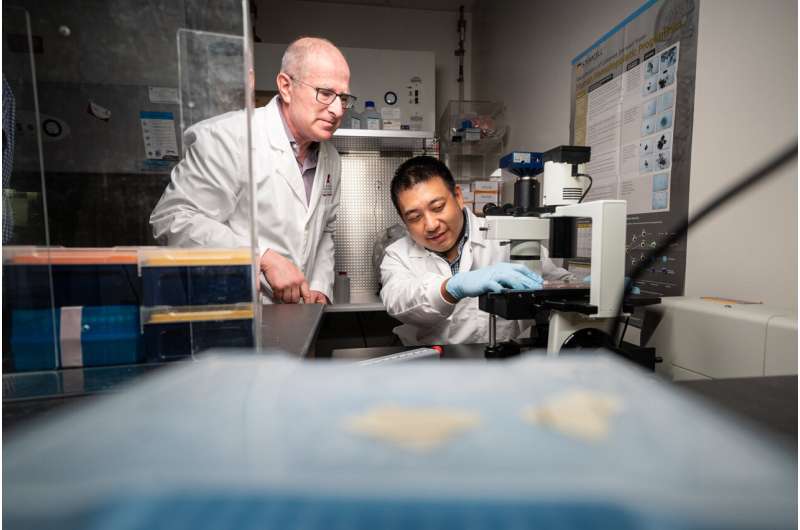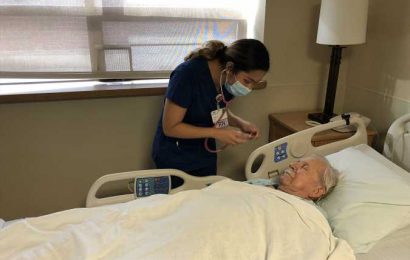
Gene therapy that alters hemoglobin genes may be an answer to curing sickle cell disease (SCD) and beta thalassemia. These two common life-threatening anemias afflict millions of individuals across the globe.
Scientists at St. Jude Children’s Research Hospital and the Broad Institute of MIT and Harvard used a next-generation genome editing technology, adenosine base editing, to restart fetal hemoglobin expression in SCD patient cells. The approach raised the expression of fetal hemoglobin to higher, more stable, and more uniform levels than other genome editing technologies that use CRISPR/Cas9 nuclease in human hematopoietic stem cells. The findings were published in Nature Genetics.
SCD and beta thalassemia are blood disorders affecting millions of people; mutations in the gene that encodes an adult version of the oxygen-carrying molecule hemoglobin cause these disorders. Restoring gene expression of an alternative hemoglobin subunit active in a developing fetus has previously shown therapeutic benefit in SCD and beta thalassemia patients.
The researchers wanted to find and optimize genomic technology to edit the fetal hemoglobin gene. One alteration installed by adenosine base editing was particularly potent for restoring fetal hemoglobin expression in post-natal red blood cells.
“We showed base editors meaningfully increase fetal hemoglobin levels,” said lead corresponding author Jonathan Yen, Ph.D., St. Jude Therapeutic Genome Engineering group director. “Now, my Therapeutic Genome Engineering team is already hard at work, starting to optimize base editing to move this technology to the clinic.”
Hemoglobin holds the key
Adult hemoglobin, expressed primarily after birth, contains four protein subunits—two beta-globin and two alpha-globin. Mutations in the beta-globin gene cause sickle cell disease and beta-thalassemia. But humans have another hemoglobin subunit gene (gamma-globin), which is expressed during fetal development instead of beta-globin. Gamma-globin combines with alpha-globin to form fetal hemoglobin.
Normally around birth, gamma-globin expression is turned off, and beta-globin is turned on, switching from fetal to adult hemoglobin. Genome editing technologies can introduce mutations that turn the gamma-globin gene back on, thereby increasing fetal hemoglobin production, which can effectively substitute for defective adult hemoglobin production.
“We used a based editor to create a new TAL1 transcription factor binding site that causes particularly strong induction of fetal hemoglobin,” Yen said. “Creating a new transcription factor binding site requires a precise base pair change—something that can’t be done using CRISPR-Cas9 without generating unwanted byproducts and other potential consequences from double-stranded breaks.”
“The gamma-globin [fetal hemoglobin] gene is a good target for base editing because there are very precise mutations that can reactivate its expression to induce expression after birth, which may provide a powerful ‘one-size-fits-all’ treatment for all mutations that cause SCD and beta-thalassemia,” said co-corresponding author Mitchell Weiss, M.D., Ph.D., St. Jude Department of Hematology chair.
Thus, scientists want to restore fetal hemoglobin expression because it is a more universal treatment for major hemoglobin disorders than correcting the SCD mutation or hundreds of mutations that cause beta thalassemia. Increasing fetal hemoglobin expression has the potential to therapeutically benefit most patients with SCD or beta thalassemia, regardless of their causative mutations. Researchers have previously shown proof-of-principle with multiple genome editing approaches, but this study is the first to systematically compare these different strategies’ efficacy.
“We looked closely at the individual DNA sequence outcomes of nucleases and base editors used to make therapeutic edits of fetal hemoglobin genes. Since nucleases often generate complex, uncontrolled mixtures of many different DNA sequence outcomes, we characterized how each nuclease-edited sequence affects fetal hemoglobin expression. Then we did the same for base editing outcomes, which were much more homogeneous,” said co-corresponding author David Liu, Ph.D., Richard Merkin, Professor at Broad Institute of MIT and Harvard, whose lab invented base editing in 2016.
The study discovered that using base editing at the most potent site in the gamma-globin promoter achieved two- to four-fold greater HbF levels than Cas9 editing. They further demonstrated that these base edits could be retained in engrafting blood stem cells from healthy donors and SCD patients by putting them into immunocompromised mice.
Addressing safety concerns
“Ultimately, we showed that not all genetic approaches are equal,” Yen said. “Base editors may be able to create more potent and precise edits than other technologies. But we must do more safety testing and optimization.”
When compared for safety, base editing caused fewer genotoxic events, such as p53 activation and large deletions. Base editing was much more consistent in its edits and products—a highly desirable safety property for a clinical therapy. In contrast to conventional Cas9, which generates uncontrolled mixtures of insertion and deletion mutations termed “indels,” base editing generates precise nucleotide changes with few undesired byproducts.
“In our comparison, we found unanticipated problems with conventional Cas9 nucleases,” Weiss said. “We were somewhat surprised that not every Cas9 insertion or deletion raised fetal hemoglobin to the same extent, indicating the potential for heterogeneous biological outcomes with that technology.” The group found that individual red blood cells derived from hematopoietic stem cells treated with the same Cas9 produce a more variable amount of fetal hemoglobin compared to cells treated with base editing. Thus, base editing produced more potent, reliable, and consistent outcomes, which are desirable therapeutic properties.
Though base editing performed well, researchers have yet to determine its safety in patients. Notably, base editing may have some risks not presented by Cas9; for example, some early base editors can cause undesired changes in genomic DNA or RNA at off-target sites. The group showed that these changes are relatively small and not predicted to be harmful, but deeper studies are warranted to evaluate these risks fully.
The future of gene editing therapeutics
Throughout the study, the scientists directly compared the performance of Cas9 nucleases at two different target sites that induce fetal hemoglobin production in different ways and base editing. Base editing uses a distinct editing mechanism that directly converts one DNA base pair to another, rather than cutting the DNA double helix into two pieces.
The Cas9 nuclease approaches create mixtures of deletions and insertions that impair the expression or activity of BCL11A, a well-known gamma-globin gene repressor. In contrast, base editing creates a novel transcription factor binding motif within the gamma-globin promoter. The Cas9 nuclease approaches and a different base editing approach are being tested through clinical trials. St. Jude is participating in some of these studies.
“It is very important to test and compare different genome editing approaches for treating SCD and beta-thalassemia because the best ones are not known,” said Weiss.
More information:
Potent and uniform fetal hemoglobin induction via base editing, Nature Genetics (2023). DOI: 10.1038/s41588-023-01434-7
Journal information:
Nature Genetics
Source: Read Full Article


